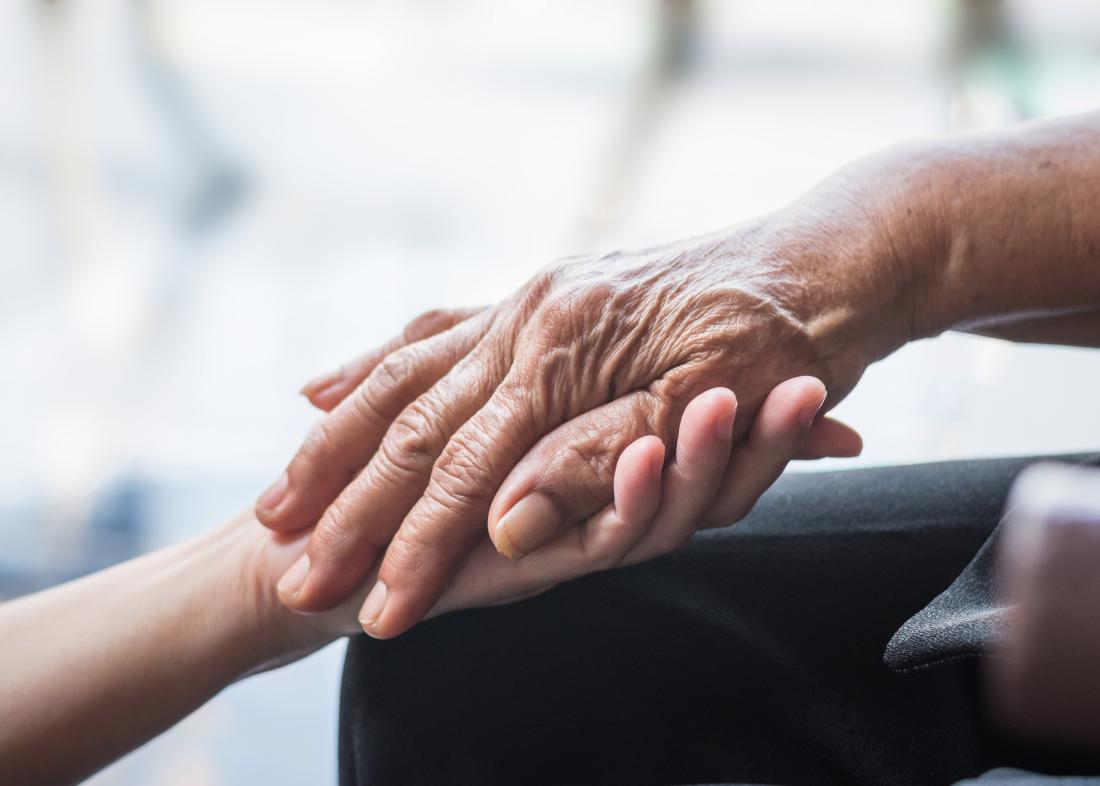Doctors may also refer to metastatic breast cancer as advanced breast cancer or stage 4 breast cancer.
Many people live for months or years after a healthcare professional has diagnosed metastatic breast cancer. Treatment can help a person live longer and slow down the progression of the cancer.
As a person with metastatic breast cancer approaches the end of life, their treatment approach might shift to palliative care.
The aim of palliative care is to improve quality of life. Palliative care helps a person cope with end-of-life symptoms and focuses on the physical, emotional, and spiritual comfort and well-being of the person and their loved ones.
In this article, we discuss the end-of-life symptoms and care for people with metastatic breast cancer. We also look at the 5-year survival rates for this stage of breast cancer.
Symptoms of metastatic breast cancer

When metastatic breast cancer stops responding to treatment, the focus may shift to end-of-life care.
The symptoms of metastatic breast cancer are different to those of early-stage breast cancer. This is because the cancer has spread to other organs and is affecting other body systems, as well as the affected breast.
Most of the time, metastatic breast cancer affects the bones, lungs, brain, or liver.
Having one or more of the following symptoms does not mean that a person has metastatic breast cancer. However, anyone who experiences these symptoms should see a doctor for an evaluation.
Bone metastasis symptoms
Metastatic breast cancer most commonly spreads to the bones. Symptoms of bone metastasis include:
- pain in the bones or joints, which may be constant or become worse with activity
- back or neck pain
- increased risk of bone fractures
- numbness or weakness in certain areas of the body
- trouble urinating
- constipation
- nausea
- lack of appetite
- extreme thirst
Lung metastasis symptoms
If breast cancer has spread to the lungs, a person may experience:
- a dry cough that does not go away
- trouble breathing or shortness of breath
- wheezing
- coughing up blood and mucus
- pain in the chest or lung area
Brain metastasis symptoms
Breast cancer that has spread to the brain can cause symptoms such as:
- headache
- changes in vision
- hearing difficulties
- balance problems or dizziness
- difficulty moving certain parts of the body
- changes in mood or personality
- memory problems
- confusion
- seizures
- stroke
Liver metastasis symptoms
When breast cancer spreads to the liver, it can cause:
- jaundice, which is a yellowing of the skin and eyes
- swelling in the abdomen due to a buildup of fluid
- pain around the liver or the upper-right abdominal region
- rashes or itching
End-of-life symptoms
When metastatic breast cancer stops responding to treatment, a person and their healthcare team may decide to shift the focus to end-of-life care. During this time, a person may experience symptoms of metastatic breast cancer in addition to end-of-life symptoms. These may include:
- Pain: Cancer can cause considerable pain as it progresses.
- Fatigue: As the body continues to cope with the spread of cancer, it is common to feel very tired. A person near the end of life may sleep for many hours per day.
- Breathing difficulties: Breathing may become difficult for several reasons. Sometimes, mucus builds up in the lungs or throat, partially blocking the airway. This can affect breathing and cause difficulty swallowing. Fluid buildup in the abdomen, or ascites, can put pressure on the lungs and make it harder for them to expand. Ascites is common in breast cancer that has spread to the liver.
- Lack of appetite: It is normal for a person to become less interested in food toward the end of life. A dry mouth and throat, changes in taste and smell, and a decreased need for calories can make it difficult for a person to eat. Nausea and constipation may also diminish the appetite.
- Weight loss: People with metastatic breast cancer can lose weight for several reasons. As their appetite decreases, their calorie intake also drops. In addition, the cancer cells consume many of the calories that the person eats.
- Confusion: Confusion and memory issues are common in late-stage cancer. Such symptoms may come and go.
- Digestive issues: Metastatic cancer can slow or disrupt digestion, which can lead to nausea, vomiting, constipation, and other digestive problems.
- Emotional changes: Coping with the end of life can cause depression, anxiety, mood swings, stress, and a variety of emotions.
All these symptoms are normal as the cancer progresses. End-of-life treatment focuses on providing relief from these symptoms and improving quality of life.
End-of-life care

Caregivers play a vital role in end-of-life care.
End-of-life symptoms can be difficult for someone with metastatic breast cancer to cope with, but palliative care can help.
Some people choose to receive in-home palliative care from nurses and other healthcare professionals. Others may choose to receive their care in a clinic that specializes in end-of-life treatment and palliative care.
A person with metastatic breast cancer may wish to speak with friends, family members, and their healthcare team about their care preferences.
A discussion about comfort measures, where a person would like to receive their care, religious or spiritual requests, and funeral preferences can be hard to initiate.
However, discussing these details in advance can help ensure that a person’s final months are more comfortable, and that caregivers can honor the person’s wishes as much as possible.
Treatment for physical symptoms
Several medications can help relieve pain. The American Cancer Society (ACS) urge that a person should not have to endure pain in the final months and days of life.
Many people find relief with opioid medications, but these can cause side effects such as fatigue and constipation. A person may use opioids in combination with other pain relief medications, such as acetaminophen or ibuprofen.
Other drugs, such as antidepressants and antiseizure medications, can also treat certain types of pain.
Doctors can also prescribe medications for nausea and vomiting. Some drugs for treating nausea can make a person drowsy. However, these drugs may help people eat and drink more or simply make it easier for them to function and interact with other people.
Emotional and spiritual care
End-of-life care also includes emotional, mental, and spiritual therapy. A person’s healthcare team may include social workers, counselors, mental health professionals, and religious or spiritual advisors.
According to the Anxiety and Depression Association of America, up to 40 percent of people with cancer experience serious mental distress. This may include anxiety, depression, panic attacks, and post-traumatic stress disorder (PTSD).
Medications, therapy, religious or spiritual rituals, and support groups can help a person cope with mental health issues and stress during this difficult time.
Caregivers may also need help with stress, anxiety, and depression. The palliative care team can usually also provide support and advice to caregivers for their emotional needs.
The role of caregivers
Caregivers also play a vital role in helping a person with cancer be as comfortable as possible. To help, a caregiver can:
- Help them out of bed. Help the person get up, if they are able to, every 1–2 hours. If they are unable to do this, help them turn in bed to keep them comfortable and avoid bed sores.
- Create a comfortable environment. Keep the person’s room at a comfortable temperature. If they are cold, get them extra blankets. Avoid using heating pads and electric blankets, which may cause burns. Also, ensure that the room is well-ventilated, such as by opening windows or using fans, so that the person can breathe more easily.
- Understand their eating patterns. Do not force a person to eat or drink unless the doctor instructs otherwise. Caregivers may become upset or concerned when a person with cancer does not eat. However, they should try to understand that it may be difficult or impossible for the person to eat or drink when they feel ill, are exhausted, or have no appetite. Try ice chips to keep the mouth moist.
- Help them conserve their energy levels. Only allow visitors that the person wants to see. If the person is exhausted, limit visitors or ask them to come to the person’s room to avoid unnecessary trips out of bed.
- Monitor their pain levels. Look for signs of pain or discomfort. Groaning, grimacing, or appearing restless could be signs that a person is in pain. Work with their healthcare provider to ensure that they are receiving adequate pain control if the person cannot do this for themselves.
- Change their position. Help them try various positions, such as being propped up on pillows, to help them breathe easier and interact with others.
- Be patient. Understand if the person cannot remember things or behaves differently. Explain to visitors, if needed, so that they are aware of these changes before interacting with the individual.
- Say comforting things. Keep in mind that the person may be able to hear you, even if they appear to be asleep or are unable to talk. This may be an opportunity to share favorite memories or comforting words with them. Avoid saying things that may cause unnecessary stress in front of them.
Survival rates
According to the American Society for Clinical Oncology, in 2018, doctors will diagnose invasive breast cancer in an estimated 268,670 people in the United States.
The ACS state that the 5-year relative survival rate for people with metastatic breast cancer is around 22 percent. This means that people with metastatic breast cancer are 22 percent as likely as people without the condition to live at least 5 years following diagnosis.
However, many factors can affect how long a person with metastatic breast cancer lives for, including:
- the type of breast cancer
- the stage of breast cancer
- where the cancer has spread to
- how well the cancer responds to treatment
- any other health issues that the person has
Everyone’s outlook is different. It is also important to note that survivals rates are just estimates, and that doctors base these figures on data from at least 5 years ago. Continuing advancements in cancer treatments means that survival rates are improving.
Summary
The end-of-life symptoms of metastatic breast cancer vary from person to person. Considering a person’s unique physical, emotional, and spiritual needs during this time can help them have the best possible quality of life in their final weeks or months.

